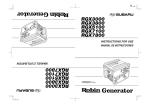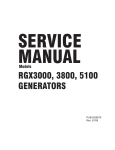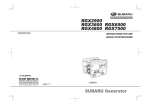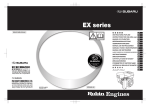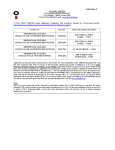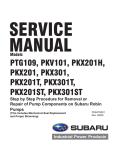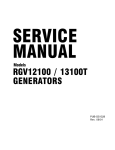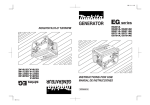Download Robin America RGX7100 Service manual
Transcript
SERVICE MANUAL Models RGX7100, 7800 GENERATORS PUB-GS6828 Rev. 07/09 Robin America, Inc. 905 Telser Road • Lake Zurich, IL 60047 • Phone: 847-540-7300• Fax: 847-438-5012 e-mail: [email protected] • www.subarupower.com © Copyright 2009 Robin America, Inc. CONTENTS Section Title Page 1. SPECIFICATIONS. . . . . . . . . . . . . . . . . . . . . . . . . . . . . . . . . . . . . . . . . . . . . . . . . . . . . . . . . . . 1 2. PERFORMANCE CURVES . . . . . . . . . . . . . . . . . . . . . . . . . . . . . . . . . . . . . . . . . . . . . . . . . . . . 2 3. GENERAL DESCRIPTION. . . . . . . . . . . . . . . . . . . . . . . . . . . . . . . . . . . . . . . . . . . . . . . . . . . . . 6 4. RANGE OF APPLICATIONS. . . . . . . . . . . . . . . . . . . . . . . . . . . . . . . . . . . . . . . . . . . . . . . . . . . 9 5. MEASURING PROCEDURES. . . . . . . . . . . . . . . . . . . . . . . . . . . . . . . . . . . . . . . . . . . . . . . . . 12 5-1 MEASURING INSTRUMENTS. . . . . . . . . . . . . . . . . . . . . . . . . . . . . . . . . . . . . . . . . . . . . . 12 5-2 AC OUTPUT MEASURING. . . . . . . . . . . . . . . . . . . . . . . . . . . . . . . . . . . . . . . . . . . . . . . . . 14 5-3 DC OUTPUT MEASURING . . . . . . . . . . . . . . . . . . . . . . . . . . . . . . . . . . . . . . . . . . . . . . . . 14 5-4 MEASURING INSULATION RESISTANCE. . . . . . . . . . . . . . . . . . . . . . . . . . . . . . . . . . . . 14 6. CHECKING FUNCTIONAL MEMBERS. . . . . . . . . . . . . . . . . . . . . . . . . . . . . . . . . . . . . . . . . . 16 6-1 RECEPTACLES. . . . . . . . . . . . . . . . . . . . . . . . . . . . . . . . . . . . . . . . . . . . . . . . . . . . . . . . . 16 6-2 CIRCUIT BREAKER. . . . . . . . . . . . . . . . . . . . . . . . . . . . . . . . . . . . . . . . . . . . . . . . . . . . . . 17 6-3 STATOR. . . . . . . . . . . . . . . . . . . . . . . . . . . . . . . . . . . . . . . . . . . . . . . . . . . . . . . . . . . . . . . 18 6-4 ROTOR ASSEMBLY. . . . . . . . . . . . . . . . . . . . . . . . . . . . . . . . . . . . . . . . . . . . . . . . . . . . . . 19 6-5 BRUSH. . . . . . . . . . . . . . . . . . . . . . . . . . . . . . . . . . . . . . . . . . . . . . . . . . . . . . . . . . . . . . . . 20 6-6 A.V.R. (AUTOMATIC VOLTAGE REGULATOR). . . . . . . . . . . . . . . . . . . . . . . . . . . . . . . . 20 6-7 DIODE STACK. . . . . . . . . . . . . . . . . . . . . . . . . . . . . . . . . . . . . . . . . . . . . . . . . . . . . . . . . . 22 6-8 OIL SENSOR . . . . . . . . . . . . . . . . . . . . . . . . . . . . . . . . . . . . . . . . . . . . . . . . . . . . . . . . . . . 23 6-9 IDLE CONTROL (OPTIONAL EQUIPMENT). . . . . . . . . . . . . . . . . . . . . . . . . . . . . . . . . . . . . . . 24 7. DISASSEMBLY AND ASSEMBLY . . . . . . . . . . . . . . . . . . . . . . . . . . . . . . . . . . . . . . . . . . . . . 27 7-1 PREPARATION and PRECAUTIONS . . . . . . . . . . . . . . . . . . . . . . . . . . . . . . . . . . . . . . . . 27 7-2 DISASSEMBLY PROCEDURES . . . . . . . . . . . . . . . . . . . . . . . . . . . . . . . . . . . . . . . . . . . . 27 7-3 COMPONENT PARTS. . . . . . . . . . . . . . . . . . . . . . . . . . . . . . . . . . . . . . . . . . . . . . . . . . . . 33 7-4 ASSEMBLY PROCEDURES . . . . . . . . . . . . . . . . . . . . . . . . . . . . . . . . . . . . . . . . . . . . . . . 37 7-5 CHECKING, DISASSEMBLY and REASSEMBLY of the CONTROL PANEL . . . . . . . . . . 48 8. TROUBLESHOOTING. . . . . . . . . . . . . . . . . . . . . . . . . . . . . . . . . . . . . . . . . . . . . . . . . . . . . . . 49 8-1 NO AC OUTPUT. . . . . . . . . . . . . . . . . . . . . . . . . . . . . . . . . . . . . . . . . . . . . . . . . . . . . . . . . 49 8-2 AC VOLTAGE IS TOO HIGH OR TOO LOW. . . . . . . . . . . . . . . . . . . . . . . . . . . . . . . . . . . 50 8-3 AC VOLTAGE IS NORMAL AT NO-LOAD, BUT THE LOAD CANNOT BE APPLIED. . . . 51 8-4 NO DC OUTPUT. . . . . . . . . . . . . . . . . . . . . . . . . . . . . . . . . . . . . . . . . . . . . . . . . . . . . . . . . 52 9. WIRING DIAGRAM . . . . . . . . . . . . . . . . . . . . . . . . . . . . . . . . . . . . . . . . . . . . . . . . . . . . . . . . . 53 NOTE This Service Manual excludes information for engine. As for the total servicing information as a generator set, please refer in conjunction with the Robin EX35/40 OHC Engine Service Manual. 1. SPECIFICATIONS MODEL RGX7100 Type RGX7800 Brush, self-exciting, 2-poles, single phase Voltage regulating system AVR type AC Output Rated voltage Generator Rated current Rated output V A VA (W) 50Hz 220, 240 60Hz 120 / 240 50Hz 20.9, 19.2 25, 22.9 60Hz 41.7 / 20.8 50 / 25 50Hz 4600 5500 60Hz 5000 6000 Rated power factor 1.0 Safety device type Fuse-less circuit breaker DC Output Rated voltage V 12 Rated current A 8.3 Safety device type Fuse-less circuit breaker Model EX35D Type Engine Displacement ROBIN, Air-cooled, 4-stroke, OHC, Gasoline Engine mL 404 Fuel Automotive Unleaded Gasoline Fuel tank capacity L Engine oil capacity L 22.0 (27.5)*1 1.2 Spark plug BR-6HS (NGK) Starting system Electric starter / Recoil Direction of rotation Dimension EX40D Counter - clockwise Length mm 725 (975)*2 Width mm 530 Height mm 580 Dry weight kg 86(96)*3 Specifications are subject to change without notice. *1: ( ) shows the filled amount up to the "LEVEL" position. *2: ( ) shows dimensions with Battery frame. *3: ( ) shows dry weight with Electric starter. -1- 88(98 )*3 2. PERFORMANCE CURVES •RGX7100 50Hz-220V N/A 50Hz-240V N/A -2- 60Hz-120/240V Voltage (V) 62.5 7000 60 6000 57.5 5000 55 4000 250 [125] 3000 240 [120] 2000 230 [115] 1000 0 10 20 30 40 50 60 Current (A) -3- 70 0 Output (VA) Frequency (Hz) 8000 Voltage (V) Frequency (Hz) Output (VA) •RGX7800 50Hz-220V N/A 50Hz-240V N/A -4- 60Hz-120/240V Voltage (V) 65 8000 62.5 7000 60 6000 57.5 5000 55 4000 250 [125] 3000 240 [120] 2000 230 [115] 1000 0 10 20 30 40 50 60 Current (A) -5- 70 0 Output (VA) Frequency (Hz) 9000 Voltage (V) Frequency (Hz) Output (VA) 3. GENERAL DESCRIPTION RGX7100, RGX7800 Tank cap Engine switch Control panel Fuel strainer (Fuel valve) Recoil starter handle Oil gauge (oil filler) Recoil starter Oil drain plug Fuel gauge Fuel tank Choke lever Spark plug cap Air cleaner Muffler Muffler cover -6- CONTROL PANEL (50Hz-220V, 240V) AC receptacle AC circuit breaker Voltmeter [Electric starter model] V Key switch DC circuit breaker Engine switch Earth (ground) terminal DC receptacle (60Hz-120/240V) AC receptacle 30A AC receptacle 30A Idle Control Switch AC receptacle 20A Pilot lamp [Electric starter model] AC circuit breaker Key switch DC circuit breaker Engine switch Full power switch Hour meter Earth (ground) terminal -7- DC receptacle SERIAL NUMBER Serial number is stamped on the label stuck on the control box. NOTE : Always specify serial number when inquiring about the generator or ordering spare parts in order to get correct parts and accurate service. PROD No. / SER No. (Label) CONSTRUCTION •RGX7100 / RGX7800 STATOR CORE END COVER EARTH TERMINAL BRUTH BRUSH HOLDER FLANGE BOLT DIODE STACK ROTOR BOLT AVR UNIT STATOR BOLT FRONT COVER REAR COVER -8- N-BRACKET 4. RANGE OF APPLICATIONS Generally, the power rating of an electrical appliance indicates the amount of work that can be done by it. The electric power required for operating an electrical appliance is not always equal to the output wattage of the appliance. The electrical appliances generally have a label showing their rated voltage, frequency, and power consumption (input wattage). The power consumption of an electrical appliance is the power necessary for using it. When using a generator for operating an electrical appliance, the power factor and starting wattage must be taken into consideration. In order to determine the right size generator, it is necessary to add the total wattage of all appliances to be connected to the unit. Refer to the followings to calculate the power consumption of each appliance or equipment by its type. (1) Incandescent lamp, heater, etc. with a power factor of 1.0 Total power consumption must be equal to or less than the rated output of the generator. Example : A rated 3000W generator can turn thirty 100W incandescent lamps on. (2) Fluorescent lamps, motor driven tools, light electrical appliances, etc. . with a smaller power factor Select a generator with a rated output equivalent to 1.2 to 2 times of the power consumption of the load. Generally the starting wattage of motor driven tools and light electrical appliances are 1.2 to 3 times lager than their running wattage. Example: A rated 250 W electric drill requires a 400 W generator to start it. NOTE 1: If a power factor correction capacitor is not applied to the fluorescent lamp, the more power shall be required to drive the lamps. NOTE 2: Nominal wattage of the fluorscent lamp generally indicates the output wattage of the lamp. Therefore, if the fluorescent lamp has no special indication as to the power consumption, efficiency should be taken into account as explained in ltem (5) on the following page. (3) Mercury lamps with a smaller power factor Loads for mercury lamps require 2 to 3 times the indicated wattage during start-up. Example : A 400 W mercury lamp requires 800 W to 1200 W power source to be turned on. A rated 3000 W generator can power two or three 400 W mercury lamps. (4) Initially loaded motor driven appliances such as water pumps, compressors, etc. These appliances require large starting wattage which is 3 to 5 times of running wattage. Example : A rated 900 W compressor requires a 4500 W generator to drive it. NOTE 1: Motor-driven appliances require the aforementioned generator output only at the starting. Once their motors are started, the appliances consume about 1.2 to 2 times their rated power consumption so that the excess power generated by the generator can be used for other electrical appliances. NOTE 2 : Motor-driven appliances mentioned in items (3) and (4) vary in their required motor starting power depending on the kind of motor and start-up load. If it is difficult to determine the optimum generator capacity, select a generator with a larger capacity. -9- (5) Appliances without any indication as to power consumption Some appliances have no indication as to power consumption; but instead the work load (output) is indicated. In such a case, power consumption is to be worked out according to the numerical formula mentioned below. (Output of electrical appliance) = (Power consumption) (Efficiency) Efficiencies of some electrical appliances are as follows : Single-phase motor . . . 0.6 to 0.75 Fluorescent lamp . . . . . 0.7 to 0.8 ( The smaller the motor, the lower the efficiency. ) Example 1 : A 40W fluorescent lamp means that its luminous output is 40W. Its efficiency is 0.7 and accordingly, power consumption will be 40÷0.7= 57W. As explained in Item (2), multiply this power consumption value of 57 W by 1.2 to 2 and you will get the figure of the necessary capacity of a generator. In other words, a generator with a rated output of 1000W capacity can light nine to fourteen 40 W fluorescent lamps. Example 2 : Generally speaking, a 400 W motor means that its work load is 400 W. Efficiency of this motor is 0.7 and power consumption will be 400÷0.7= 570 W. When this motor is used for a motor-driven tool, the capacity of the generator should be multiple of 570 W by 1.2 to 3 as explained in the ltem (3). 570 (W) × 1.2 to 3 = 684 (W) to 1710 (W) Applicable Wattage(approx. W) Applications 50Hz 60Hz RGX7100 RGX7800 RGX7100 RGX7800 Incandescent lamp, Heater 4600 5500 5000 6000 Fluorescent lamp, Electric tool 2550 3000 2750 3300 Mercury lamp 1850 2200 2000 2400 Pump, Compressor 1150 1350 1250 1500 Table. 4-1 - 10 - NOTES : Wiring between generator and electrical appliances 1. Allowable current of cable Use a cable with an allowable current that is higher than the rated input current of the load (electrical appliance). If the input current is higher than the allowable current of the cable used, the cable will become excessively heated and deteriorate the insulation, possibly burning it out. Table 4-2 shows cables and their allowable currents for your reference. 2.Cable length If a long cable is used, a voltage drop occurs due to the increased resistance in the conductors decreasing the input voltage to the load (electrical product). As a result, the load can be damaged. Table 4-2 shows voltage drops per 100 meters of cable. Allowable No.of strands. Resistance current / strands dia. Current Amp. mm2 No. A No./mm Ω/100m 1A 0.75 18 7 30/0.18 2.477 2.5V 7.5V 12.5V 1.25 16 12 50/0.16 1.486 1.5V 4.5V 2.0 14 17 37/0.26 0.952 1V 3.5 12 to 10 23 45/0.32 0.517 5.5 10 to 8 35 70/0.32 0.332 3A 5A 8A 10A 12A 15A - - - - 7.5V 12V 15V 18V - 3V 5V 8V 10V 12V 15V - 1.5V 2.5V 4V 5V 6.5V 7.5V - 1V 2V 2.5V 3.5V 4V 5V Table. 4-2 Voltage drop indicates as V= 1 × R × I × L 100 Rmeans resistance (Ω/100 m) on the above table. I means electric current through the wire (A). L means the length of the wire (m). The length of wire indicates round length, it means twice the length from generator to electrical tools. - 11 - Voltage drop Nominal . cross . A.W.G. section 5. MEASURING PROCEDURES 5-1 MEASURING INSTRUMENTS (1) VOLTMETER AC voltmeter is necessary. The approximate AC voltage ranges of the voltmeters to be used for various types of generators are as follows : 0 to 150 V : Type with an output voltage of 110 or 120 V 0 to 300 V : Type with an output voltage of 220, 230 or 240 V 0 to 150 V, 0 to 330 V : Dual voltage type FOR AC (2) A MMETER AC ammeter is necessary. An AC ammeter with a range that can be changed according to the current rating of a given generator is most desirable. (About 10 A, 20 A, 100 A) FOR AC (3) F REQUENCY METER Frequency range : About 45 to 65Hz NOTE : Be careful of the frequency meter's input voltage range. - 12 - (4) C IRCUIT TESTER Used for measuring resistance, etc. (5) M EGGER TESTER Used for measuring generator insulation resistance. Select one with testing voltage range of 500V. (6) T ACHOMETER Use the contactless type tacho meter. - 13 - 5-2 AC OUTPUT MEASURING SWITCH LOAD A ~ F V ~ Use a circuit above for measuring AC output. A hot plate or lamp with a power factor of 1.0 may be used as a load. Adjust the load and rpm. and check that the voltage range is as specified in the following table at the rated amperage and rated rpm. Model RGX7100 RGX7800 Hz Rated voltage 120V 220V 240V 50 - 219 - 228 239 - 248 60 118 - 127 219 - 228 239 - 248 50 - 219 - 228 239 - 248 60 118 - 127 219 - 228 239 - 248 Voltage range TO AC RECEPTACLE 5-3 DC OUTPUT MEASURING Measurement of DC output is executed with the switch turned ON while the current is regulated at 8.3A by adjusting the load to the generator. If the voltage is within the range from 10V, the voltage output is normal. NOTE : If a battery is connected as a load to the generator, the DC output voltage will increase by approximately 1 to 2 V. Therefore, carefully observe the electrolyte level and do not overcharge the battery. 5-4 MEASURING INSULATION RESISTANCE Use a megger tester to check the insulation resistance. Remove the control panel, and disconnect the connector of GREEN lead for ground. Connect a megger tester to one of receptacle output terminals and the ground terminal, then measure the insulation resistance. MEGGER TESTER - 14 - An insulation resistance of 1 megohm or more is normal. (The original insulation resistance at the time of shipment from the factory is 10 megohm or more.) If it is less than 1 megohm, disassemble the generator and measure the insulation resistance of the stator, rotor and control panel individually. (1) STATOR Measure the insulation resistance between each lead wire and the core. MEGGER TESTER (2) ROTOR Measure the insulation resistance between the slip ring and the core. SLIP RING ROTOR MEGGER TESTER (3) CONTROL PANEL Measure the insulation resistance between the live parts and the grounded parts. MEGGER TESTER Any part where the insulation resistance is less than 1MΩ has faulty insulation, and may cause electric leakage and electric shock. Replace the faulty part. - 15 - 6. CHECKING FUNCTIONAL MEMBERS 6-1 RECEPTACLES Using a circuit tester, check continuity between the two terminals at the rear of the receptacles while the receptacle is mounted on the control panel. When continuity is found between the output terminals of the receptacle with a wire connected across these terminals, the receptacle is normal. When the wire is removed and no continuity is found between these terminals, the receptacles are also normal. CIRCUIT TESTER (Continuity test) CIRCUIT TESTER (Continuity test) WIRE - 16 - 6-2 CIRCUIT BREAKER Check continuity between each of two terminals at the rear of the circuit breaker while it is mounted on the control panel. PUSH type REVER type A A Normally, there is continuity between each of the two when the circuit breaker is on while there is no continuity when the circuit breaker is off. Type 1 Type 3 B B •AC CIRCUIT BREAKER Model RGX7100 RGX7800 Frequency Rated output 50Hz 4600VA 60Hz 5000VA 50Hz 5500VA 60Hz 6000VA Rated voltage Rated fault current 220V 20 1 240V N/A 1 120/240V 23 3 220V N/A 1 240V N/A 1 120/240V 28 3 •DC CIRCUIT BREAKER Model RGX7100 RGX7800 Type Rated current Rated voltage Rated fault current Type 8.3A 12V 10A 1 - 17 - CIRCUIT TESTER (Continuity test) 6-3 STATOR Disengage connectors on the wires from stator and check the resistance between wires with a circuit tester referring to the following table. NOTE : If the circuit tester is not sufficiently accurate, it may not show the values given and may give erroneous readings. Erroneous readings will also occur when there is a wide variation of resistance among coil windings or when measurement is performed at ambient temperatures different from 20 °C (68 °F). AC winding 1 Grn W Sub coil Blu Grn W Blu Gry Org AC winding 2 R Blu Grn Blu Blu AVR unit DC winding W CIRCUIT TESTER (Resistance) R Brn Bridge diode Brn W Blk •RGX7100 (Ω) FREQUENCY 50Hz RATED VOLTAGE 60Hz 220V 240V 120/240V AC WINDING 1 RED - GRAY 0.56 0.69 0.60 AC WINDING 2 ORANGE - BLUE 0.56 0.69 0.60 SUB COIL BLUE - BLUE 1.64 1.74 1.53 DC WINDING BROWN - BROWN 0.12 0.13 0.10 AC WINDING 1 GREEN - WHITE 0.10 0.12 0.10 •RGX7800 (Ω) FREQUENCY 50Hz RATED VOLTAGE 60Hz 220V 240V 120/240V AC WINDING 1 RED - GRAY 0.59 0.64 0.41 AC WINDING 2 ORANGE - BLUE 0.59 0.64 0.41 SUB COIL BLUE - BLUE 1.80 1.76 1.35 DC WINDING BROWN - BROWN 0.13 0.10 0.09 AC WINDING 1 GREEN - WHITE 0.10 0.11 0.07 - 18 - 6-4 ROTOR ASSEMBLY 1) Field coil Remove the brush holder and measure resistance between the slip rings. CIRCUIT TESTER (Resistance) SLIP RING (Ω) 50Hz Rotor. (Slip ring) 220V 240V 60Hz 120/240V RGX7100 49.0 49.0 49.0 RGX7800 55.0 55.0 55.0 ROTOR NOTE : If the circuit tester is not sufficiently accurate, it may not show the values given and may give erroneous readings. Erroneous reading will also occur when there is a wide variation of resistance among coil windings or when measurement is performed at ambient temperatures different from from 20°C (68°F). 2) Cleaning Slip rings The slip ring surfaces must be uniformly bright. Slip rings showing black spots, excessive wear, or uneven wear must be repaired. A stained slip ring lowers generator efficiency and output voltage. Polish the slip rings with fine sandpaper while turning the rotor until rough spots disappear. Care should be taken not to touch the rotor coils with the sandpaper. - 19 - SLIP RING ROTOR SANDPAPER 6-5 BRUSH The brushes must be smooth where they contact the slip rings. If not, polish smooth the brushes with sandpaper. A brush that is not smooth produces arcs between the brush and slip ring leading to possible damage. Usable brush lengths are from 5 mm to 11 mm (0.20 " to 0.43"). A brush shorter than 5 mm must be replaced because decreased contact pressure between the brush and slip ring lowers generator efficiency and output voltage. BRUSH HOLDER BRUSH 6-6 A.V.R. . (AUTOMATIC VOLTAGE REGULATOR) 1) Features This A.V.R. operates to control the field current in order to maintain the output voltage for the AC current, which generated by the magnetic flux by the field coil. 5 mm CIRCUIT TESTER (Resistance) 2) A .V.R. trouble may be identified by simply looking at the A.V.R., or by the inter-lead resistance with a tester, or actually mounting it in the generator and operating it. (a) A .V.R. TROUBLE IDENTIFICATION by APPEARANCE If an A.V.R. electronic part is burnt dark, or the surface epoxy resin melted, it often indicates A.V.R. trouble. (b) IDENTIFYING A.V.R. TROUBLE by CHECKING INTER-LEAD RESISTANCE Check the inter-lead resistance of the A.V.R. with a tester, referring to the following table. If the tester readings very greatly from the values specified in the table on next page, the A.V.R. is faulty. NOTE : Take tester inaccuracy into account in reading the tester. - 20 - (c) IDENTIFYING A.V.R. TROUBLE by MOUNTING and OPERATING in THE GENERATOR ⓐⓑ SCR or transistor damage cannot be detected by simply looking at the A.V.R. or checking the lead resistance. Check it by mounting the suspectedly faulty A.V.R. in a normal generator, or mount a mormal A.V.R. in a generator which fails to generate voltage. ① ② ③ ④ ⓐ White ⓑ Red ① Green AVR unit ② White ③ Blue ④ Blue * Checking table for analogue circuit tester. RGX7100 / RGX7800 (Ω) (R±20%) Apply black ⊖ needle of the circuit tester White ⓐ Red ⓑ Green ① White ② Blue ③ Blue ④ - 2.1M 5.0M 5.1M 4.6M 4.2M Red ⓑ 1.8M - 2.1M 2.1M 1.9M 1.6M Green ① 4.4M 2.0M - 4.9M 4.4M 4.1M White ② 4.6M 2.1M 5.1M - 4.6M 4.2M Blue ③ 4.0M 1.7M 4.5M 4.5M - 3.8M Blue ④ 4.2M 1.8M 4.7M 4.7M 4.2M - White ⓐ Apply red ⊕ needle of the circuit tester - 21 - 6-7 DIODE STACK CIRCUIT TESTER (Continuity test) Brown Black White White Brown DIODE STACK Black Brown Brown Fig.6-8a Fig.6-8b Circuit inside of the diode stack is as shown in Fig.6-8a. Check continuity between each terminal by using a circuit tester as shown in Fig.6-8b. The diode stack is normal when continuity is as follows: * Checking table for analogue circuit tester. Analogue circuit tester Apply red ⊕ needle of the circuit tester Apply black ⊖ needle of the circuit tester Brown Brown White Black Brown - No continuity Continuity No continuity Brown No continuity - Continuity No continuity White No continuity No continuity - No continuity Black Continuity Continuity Continuity - * Checking table for digital circuit tester. Apply red ⊕ needle of the circuit tester Digital circuit tester Apply black ⊖ needle of the circuit tester Brown Brown White Black Brown - No continuity Continuity No continuity Brown No continuity - Continuity No continuity White No continuity No continuity - No continuity Black Continuity Continuity Continuity - NOTE 1 : In checking the diode , direction of connection is contrary to the ordinary case because of characteristics of the diode and battery incorporated in the tester. NOTE 2 : "Continuity" means forward direction characteristics of the diode, and different from short circuit condition (In which a pointer of the tester goes out of its normal scale), shows resistance to some extent. When results of the checking indicates failure even in one section, replace with a new one. - 22 - 6-8 OIL SENSOR (1) D isconnect wires comming from the sensor at the connection. (2) L oosen the sensor to remove it from the engine. (3) P lug the opening of oil filler hole (created after sensor is removed) with suitable means such as oil gauge. (4) C onnect the removed wires again with the oil sensor. (5) S tart the engine with the oil sensor removed and confirm if ; a. Engine stops after 5 seconds which is normal, or b. Engine does not stop after more than 10 seconds which is unusual. NOTE : The sensor will not operate properly when wire is broken or poorly connected. Check the wires for correct connection. If it fails to stop within 5 seconds after the wirings have checked, the sensor is wrong. Replace the sensor with new one. 6-8-1 SPECIFICATIONS Type Float type (with lead switch incorporated) Resistance . (at FULL oil level) 100 M ohms or over Operating Temperature -30 to +180 degree Celsius OIL SENSOR 6-8-2 CONSTRUCTION AND OPERATION Disconnect wires comming from the sensor The oil sensor is composed of the float, permanent magnet incorporated into the float and the oil sensor. In accordance with the oil level, the float moves up and down. When the oil level is upper level, the float moves up. FLOAT PERMANENT MAGNET LEAD SWITCH When the oil level is lower level, the float moves down. The permanent magnet is close to the lead switch, and the lead switch is activated by the magnetic force. NOTE : With regards to the wiring diagram, please refer to the section 9 (page46). - 23 - MAGNETIC FORCE 6-9 IDLE CONTROL (OPTIONAL EQUIPMENT) (1) ENGINE SPEED IS NOT INCREASED WHEN A LOAD IS APPLIED 1) Check the wattage of load applied to the generator. If the generator is loaded over the rated wattage, the engine speed can not be increased. Most induction loads such as electric motor or electric tools or welding machine require three to five times large wattage of their ratings at starting. This starting wattage must not exceed the rated output of the generator. 2) Check the slow set r.p.m. The normal idling speed by the IDLE CONTROL is as follows : RGX7100/7800 (USA model) . . . 2100 to 2500 r.p.m. The above speed setting is for cold engine condition. If the engine speed is out of adjusting range, move the solenoid backward. - 24 - 3) C heck the wiring through ZCT on the IDLE CONTROL UNIT. IDEL CONTROL UNIT Make sure that an output wire from main coil is passing through the ZCT on the IDLE CONTROL UNIT. OUTPUT WIRE ZCT 4) C hecking the IDLE CONTROL UNIT Check the resistance between five leads of IDLE CONTROL UNIT with circuit tester. 5 1 CIRCUIT TESTER (Resistance) 4 2 3 Terminal number of the IDEL CONTROL UNIT Apply black ⊖ needle of the circuit tester Circuit tester . (with battery power source 1.5 V) Apply red ⊕ needle of the circuit tester ① ② ③ ④ ⑤ ① - ∞ 250kΩ 250kΩ 75kΩ ② ∞ - ∞ ∞ ∞ ③ 250kΩ ∞ - 250kΩ 75kΩ ④ 250kΩ ∞ 250kΩ - 75kΩ ⑤ 8.5kΩ ∞ 7.8kΩ 7.8kΩ - NOTE : The resistance readings vary depending on the types of circuit testers. The above table shows an example of the resistance readings measured by an ordina,y analogue circuit tester with I . 5 volt battery power source. It is advisable for you to check the resistance readings using your standard circuit tester and revise the checking table. - 25 - (2) ENGINE SPEED IS NOT REDUCED . WHEN LOAD IS OFF 1) Check the wiring of SOLENOID. Check two leads from SOLENOID are securely connected. 2) Check the wiring of IDLE CONTROL UNIT. Check all leads from IDLE CONTROL UNIT are securely and correctly connected. 3) C hecking the SOLENOID. Measure the resistance between two leads from SOLENOID. Normal Resistance (Ω) SOLENOID 25 - 31 If the resistance is larger or smaller than this range, SOLENOID is defective, Replace with a new one. - 26 - 7. DISASSEMBLY AND ASSEMBLY 7-1 PREPARATION and PRECAUTIONS (1) B e sure to memorize the location of individual parts when disassembling the generator so that the generator can be reassembled correctly. Tag the disassembled part with the necessary information to facilitate easier and smoother reassembly. (2) F or more convenience, divide the parts into several groups and store them in boxes. (3) T o prevent bolts and nuts from being misplaced or installed incorrectly, replace them temporarily to their original position. (4) H andle disassembled parts with care; clean them before reassembly using a neutral cleaning fluid. (5) R emove the battery before disassembling the generator. (Electric start models) (6) Use all disassembly/assembly tools properly, and use the proper tool for each specific job. (7) B e sure to attach the foam rubber linings inside the covers on their original position when reassembling the generator. When deformation or damage or falling-off of foam rubber lining is found, replace it with new part. Failure to do so will result in poor performance and durability of the generator. (8) B ind the wires and fuel pipes using wire bands as they have been done in original configuration. NOTE : As to detailed information for servicing procedures on engine portion, please refer to Robin engine service manual for "EX35/40". 7-2 DISASSEMBLY PROCEDURES 7-2-1 FUEL TANK (1) S hut the fuel strainer and discharge fuel from caburetor. FUEL TANK FLANGE BOLT RUBBER (TANK) (2) Disconnect rubber pipe from the strainer. (3) R emove the fuel tank. M6 flange bolt . . . 4 pcs. Rubber(tank) . . . 4 pcs. - 27 - 7-2-2 CONTROL PANEL and CONTROL BOX (1) R emove the control panel. M6 flange bolt . . . 4 pcs. M4 flange bolt . . . 4 pcs. CONTROL BOX (2) D isconnect the connectors on the wiring from the control panel to the alternator. (3) R emove the control box. CONTROL PANEL CONTROL PANEL M4 M6 7-2-3 MUFFLER (1) R emove the Muffler Cover (R). M6 flange bolt . . . 11 pcs. MUFFLER COVER (R) (2) L oose the bolt for Muffler Cover (F). M6 flange bolt . . . 2 pcs. NOTE : Do not remove the flange bolt at this process. MUFFLER COVER (F) - 28 - (3) R emove the Muffler Bracket 2 from Muffler Bracket 1. M8 flange bolt . . . 2 pcs. (4) L oosen Nut and Washer for Exhaust Pipe. Remove the Muffler from Cylinder Head. MUFFLER M8 nut and washer . . . 2 pcs. (Exhaust Pipe) (5) R emove the Muffler Cover (F). M6 flange bolt . . . 2 pcs. MUFFLER COVER (F) (6) R emove the Muffler Bracket 1 from Rear Cover. M8 flange bolt . . . 1 pc. (Bracket) M10 flange nut . . . 1 pc. (with Rear Cover) MUFFLER BRACKET 1 (7) R emove the Guide plate and the Bracket (Tank A) from frame. BRACKET (TANK A) M6 flange bolt . . . 4 pcs. (Guide plate) M6 flange bolt . . . 4 pcs. (Bracket / Tank A) GUIDE PLATE - 29 - 7-2-4 ALTERNATOR (1) R emove the end cover. M6 flange bolt . . . 2 pcs. Disconnect the connectors END COVER FLANGE BOLT (2) D isconnect the connectors on the wiring from the alternator. EARTH (GROUND) WIRE DIODE STACK (3) R emove the AVR unit, brush holder and diode stack. BRUSH HOLDER EARTH (GROUND) WIRE (4) S et the generator set with the rear cover upwards. REAR COVER AVR UNIT MOUNT RUBBER NOTE : Before starting this work, make sure engine oil has been discharged. (5) R emove the flange nut fixing rear cover onto the mount base with mount rubber. M10 flange nut . . . 1 pc. FLANGE NUT *Opposite side flange nut has been removed at muffler disassembly process. - 30 - (6) R emove the rear cover. RGX7100 M6 × 180mm . . . 4 pcs. RGX7800 M6 × 195mm . . . 4 pcs. (7) T ake out stator cover with crows (2 pcs) raised up by using screw driver. (8) Remove the stator. NOTE : The stator is heavy. Be careful do not hit the coil of the stator to the rotor. STATOR COVER (9) Take off the through bolt of the rotor. (10) Use a bolt and oil as a tool for pulling out rotor in the following procedures : 1. Pour engine oil into the center hole of rotor shaft. Fill with oil to the shaft end. 2. Prepare a bolt with the following thread size : M12 × 1.75 (RGX7100 / RGX7800) - 31 - 3. Apply a few turns of seal tape around the tip of the bolt. SEAL TAPE SEAL TAPE 4. Screw the bolt into the thread of the rotor shaft. 5. Torque the bolt using a socket wrench until the rotor comes off loose. * The hydraulic pressure inside the rotor shaft takes apart the rotor from the engine shaft. (11) Remove the front cover. M8 × 20 bolt(countersunk head) . . . 4 pcs. - 32 - FRONT COVER 7-3 COMPONENT PARTS (1)Generator assembly RGX7100 / RGX7800 24.0-26.0 N-m 240-260 kgf-cm 17.7-19.2 ft-lbs 16.5-20.5 N-m 165-205 kgf-cm 12.2-15.2 ft-lbs 43.0-47.0 N-m 430-470 kgf-cm 31.7-34.7 ft-lbs THROUGH BOLT BOLT BOLT ROTOR FRONT COVER STATOR COVER N-BRACKET FAN BEARING STATOR REAR COVER DIODE STACK BRUSH HOLDER FLANGE NUT SPONGE (FILTER) 24.0-30.0 N-m 240-300 kgf-cm 17.8-22.2 ft-lbs COVER BOLT END COVER 6.5-8.5 N-m 65-85 kgf-cm 4.8-6.3 ft-lbs MOUNT RUBBER AVR UNIT - 33 - (2) Control Box Assy CONTROL BOX CONTROL PANEL ENGINE SWITCH AC RECEPTACLE KEY SWITCH AC CIRCUIT BREAKER FULL POWER SWITCH EARTH (GROUND) TERMINAL HOUR METER DC CIRCUIT BREAKER DC RECEPTACLE - 34 - IDEL CONTROL UNIT (3) Fuel Tank FUEL TANK CAP FUEL GAUGE FUEL FILTER FUEL STRAINER FUEL TANK FILTER PACKING CUP BRACKET(TANK-A) RUBBER PIPE M6 × 16 BOLT - 35 - (4) Muffler M6 × 12 flange bolt M8 flange bolt MUFFLER BRACKET 12.0-15.0 N-m 120-150 kgf-cm 8.9-11.1 ft-lbs M8 flange nuts DUCT (CASE) M8 flange bolt A 18.0-22.0 N-m 180-220 kgf-cm 13.3-16.2 ft-lbs 23.0-30.0 N-m 230-300 kgf-cm 17.0-22.2 ft-lbs M8 flange nuts 12.0-15.0 N-m 120-150 kgf-cm 8.9-11.1 ft-lbs 6.5-8.5 N-m 65-85 kgf-cm 4.8-6.3 ft-lbs M8 flange nuts EX. PIPE 18.0-22.0 N-m 180-220 kgf-cm 13.3-16.2 ft-lbs EX. PIPE 12.0-15.0 N-m 120-150 kgf-cm 8.9-11.1 ft-lbs M8 flange nuts MUFFLER BRACKET 1 A 18.0-22.0 N-m 180-220 kgf-cm 13.3-16.2 ft-lbs M8 flange bolt MUFFLER 5-6.5 N-m 50-65 kgf-cm 3.7-4.8 ft-lbs GUIDE PLATE 6.5-8.5 N-m 65-85 kgf-cm 4.8-6.3 ft-lbs MUFFLER COVER (R) MUFFLER COVER (F) MUFFLER COVER (R) - 36 - 7-4 ASSEMBLY PROCEDURES 7-4-1 ENGINE and FRAME (1) A ttach the mount rubbers to the frame. Insert the setting tongue of mount rubber into the hole on the frame and tighten the nut from the bottom of the frame. FRAME UPPER M8 flange nut . . . 4 pcs. Tightening torque : 20.0-24.0 N•m. 200-240 kgf•cm. (14.8-17.8ft•lbs) NOTE : There are two type of mount rubber. Before attaching the mount rubbers, make sure the position. ① ③ Alternator side Mount rubber (M10 × 40 bolt) : place ①,② Mount rubber (M10 × 20 bolt) : place ③,④ FRAME Engine side ② (2) T emporally attach the Mount Base to the engine by inserting flange bolt into middle hole on mount base and engine base. Temporally fix the bolt by nut. ④ MOUNT BASE NOTE : Meet other side hole on the mount base with hole of engine base. (Refer to right side picture) ENGINE M10 flange nut & M10 × 40 flange bolt . . . 1 pc. - 37 - (3) Install the engine into the frame from the side of it. Insert the bolt of mount rubbers into the hole on the mount base. Tighten the nuts over the mount rubber bolts to fix. M10 flange nut . . . 2 pcs. ENGINE Tightening torque : 24.0-30.0 N•m. 240-300 kgf•cm. (17.8-22.2ft•lbs) Tighten the temporally fixed bolt and nut for mount base. M10 flange nut & M10 × 40 flange bolt . . . 1 pc. Tightening torque : 24.0-30.0 N•m. 240-300 kgf•cm. (17.8-22.2ft•lbs) NOTE : When tightening the nuts, slightly lift the engine so that the weight is not applied to the mount rubbers. 7-4-2 FRONT COVER (1) A ttach the N-bracket onto the front cover. BOLT NOTE : Match the rib direction on the N-bracket with the top mark on the front cover surface. M8 × 20 flange bolt . . . 4 pcs. BOLT N-BRACKET FRONT COVER A Tightening torque : 16.5-20.5 N•m. 165-205 kgf•cm. (12.2-15.2ft•lbs) TOP mark RIB View A - 38 - (2) A ttach the front cover to the engine main bearing cover. TOP mark NOTE : Match the top mark on the front cover surface with upside direction. M8 × 20 bolt(countersunk head) . . . 4 pcs. Tightening torque : 24.0-26.0 N•m. 240-260 kgf•cm. (17.8-19.2ft•lbs) 7-4-3 ROTOR (1) Wipe off oil, grease and dust from the tapered portion of engine shaft and matching tapered hole of rotor shaft. FAN ROTOR (2) Mount the rotor to the engine shaft. Tighten the through bolt. THROUGH BOLT M10 × 285 flange bolt . . . 1 pc.(RGX7100) M10 × 300 flange bolt . . . 1 pc.(RGX7800) BEARING Tightening torque : 43.0-47.0 N•m. 430-470 kgf•cm. (31.8-34.8ft•lbs) 7-4-4 STATOR (1) Put the stator in the front cover. STATOR FRONT COVER - 39 - 7-4-5 REAR COVER (1)Put the rear cover over the rotor. Pull out the stator wirings through the opening of the rear cover. REAR COVER NOTE : Be careful not to give cuts to wires when pulling them out from the rear cover. PLASTIC HAMMER (2)Tap on the rear cover evenly with a plastic hammer to press the rotor bearing into the rear cover. (3) Fix the rear cover with bolts. NOTE : Tighten the bolts evenly and in turns. M6 × 180 flange bolt . . . 4 pcs. Tightening torque : 6.5-8.5 65-85 (4.8-6.3 N•m. kgf•cm. ft•lbs) REAR COVER (4) T emporally attached the Muffler Bracket 1 to the Rear Cover. M8 × 16 flange bolt . . . 1 pc. MUFFLER BRACKET 1 (5) T emporally assemble the Mount Base to the Rear Cover by inserting flange bolt into middle hole on Mount Base, Rear Cover hole and Muffler Bracket 1 hole. Temporally fix the bolt by nut. MOUNT BASE NOTE : Meet other side hole on the Mount Base with hole of Rear Cover. (Refer to right side picture) M10 flange nut & M10 × 40 flange bolt . . . 1 pc. - 40 - (6) S et the Mount Rubber bolts into the Mount Base holes. Don’t tighten the nut at this moment. REAR COVER MOUNT RUBBER FLANGE NUT (7) Install the brush holder, AVR unit and diode stack in the rear cover. M5 × 16 bolt . . . 2 pcs. (AVR unit) Tightening torque : 4.0-4.5 40-45 (3.0-3.3 N•m. kgf•cm. ft•lbs) BRUSH HOLDER AVR UNIT DIODE STACK M5 × 16 bolt . . . 2 pcs. (brush holder) M4 × 18 bolt . . . 1 pc. (diode stack) Tightening torque : 1.5-2.0 15-20 (1.1-1.5 N•m. kgf•cm. ft•lbs) Wiring color NOTE : If the brush is installed oblique to the slip ring, there is possibility that the brush holder can break when the screw is tightened : or the brush may break when generator of started. Make this process carefully. (8) Attach the connectors to the brush holder, AVR unit and diode stack. Plus ⊕ Minus ⊖ A.V.R. type (A) Blue Yellow A.V.R. type (B) Red White EARTH (GROUND) WIRE Brown White Black Brown SCREW EARTH (GROUND) WIRE DIODE STACK (9) Connect the earth (ground) wire (green/ yellow) with the rear cover with screw. BRUSH HOLDER (10) Connect earth (ground) wire between frame and rear cover. On frame side: M6 × 12 bolt . . . 1 pc. On rear cover side: 8mm nut (commonly tighten the mount rubber bolt) EARTH (GROUND) WIRE - 41 - AVR UNIT (11) Tighten the nuts over the mount rubber bolts to fix. NOTE : When tightening the nuts, slightly lift the alternator assembly so that the weight is not applied to the mount rubbers. MOUNT BASE M10 flange nut . . . 2 pcs. Tightening torque : 24.0-30.0 N•m. 240-300 kgf•cm. (17.8-22.2ft•lbs) NOTE : Do not tighten the nut and the bolt for Muffler Bracket 1. After attaching Muffler to the Engine, the nut and the bolt are fixed. (12) Set stator cover with the claw inserted into slit and bent (2 pcs). - 42 - (13) Set the Sponge(Filter) to inside of End Cover. END COVER NOTE : Hold the Sponge by tab of End Cover. SPONGE (FILTER) (14) Attach the end cover to the rear cover. M5 × 16 bolt . . . 2 pcs. Tightening torque : 4.0-4.5 40-45 (3.0-3.3 N•m. kgf•cm. ft•lbs) END COVER 7-4-6 MUFFLER and MUFFLER COVER (1) A ttach the Exhaust Pipe (with gasket), Muffler Bracket 2 and Spark Arrester to the Muffler. M8 nut and Washer . . . 2 pcs.(exhaust pipe (with gasket)) SPARK ARRESTER EXHAUST PIPE Tightening torque : 12.0-15.0 N•m. 120-150 kgf•cm. (8.9-11.1 ft•lbs) TO ENGINE MUFFLER BRACKET 2 M8 nut . . . 4pcs.(muffler bracket 2) Tightening torque : 12.0-15.0 N•m. 120-150 kgf•cm. (8.9-11.1 ft•lbs) - 43 - (2) T emporally attach the Muffler Cover (F) to the flame. M6 × 10 flange bolt . . . 4 pcs. MUFFLER COVER (F) (3) T emporally attach the muffler and gasket to the cylinder head. Temporally attach the muffler bracket 2 to Muffler bracket 1. After that, tighten the nuts and flange bolts. M8 nut . . . 2 pcs. (cylinder head) Tightening torque : 18.0-22.0 N•m. 180-220 kgf•cm. (13.2-16.2 ft•lbs) MUFFLER M8 × 16 flange bolt . . . 2 pcs. (Muffler Bracket 1) Tightening torque : 12.0-15.0 N•m. 120-150 kgf•cm. (8.9-11.1 ft•lbs) GASKET (Attention to the wrong side and right side) EXHAUST PIPE SIDE (RIGHT SIDE) CYLINDER SIDE (WRONG SIDE) Take utmost care not to cut your hand with the muffler gasket - 44 - (4) T ightening the Muffler Cover (F). M6 × 40 flange bolt . . . 2 pcs. Tightening torque : 6.5-8.5 65-85 (4.8-6.3 N•m. kgf•cm. ft•lbs) MUFFLER COVER (F) (5) T ightening the Muffler Bracket 1. MUFFLER BRACKET1 M10 nut and M10 × 40 flange bolt . . . 1 pc. (with rear cover) Tightening torque : 24.0-30.0 N•m. 240-300 kgf•cm. (17.8-22.2 ft•lbs) M8 × 16 flange bolt . . . 1 pc. Tightening torque : 16.5-20.5 N•m. 165-205 kgf•cm. (12.2-15.2 ft•lbs) (6) A ttach the muffler cover to the flame. M6 × 10 flange bolt . . . 1 1 pcs. Tightening torque : 6.5-8.5 65-85 (4.8-6.3 N•m. kgf•cm. ft•lbs) MUFFLER COVER (R) - 45 - 7-4-7 FUEL TANK (1) H and tighten the strainer screw as far as it will go, loosen it again by one or two rotations (fuel outlet faces down), then tighten the lock nut. FUEL TANK CAP FUEL GAUGE FUEL FILTER (2) M ount the fuel tank on the frame with rubber washers between the tank flange and the frame. M6 x 20 mm bolt (black) . . . 4 pcs. Rubber washer . . . 4 pcs. FUEL STRAINER FILTER NOTE : For easy tank assembly, glue the rubber washers over the mounting holes of the frame. FUEL TANK PACKING CUP (3) C onnect the rubber pipe. First, fit the hose clamps on the rubber pipe and connect it to the strainer and the carburetor. Then fasten it with the hose clamps. RUBBER PIPE BRACKET (TANK-A) M6 × 16 BOLT NOTE : Apply a drop of oil to the rubber pipe for easier connection. - 46 - 7-4-8 CONTROL BOX ASSY Refer to Section 7-5 for disassembly, checking and reassembly procedures of the control panel. (1) P ut the cover onto the frame temporary. CONTROL BOX NOTE : Don't set bolt for the control box. (2) P ass wires drawn out generator and engine to the control box. (3) C onnect the wires coming from the control panel with wires coming from generator and engine. NOTE : Connect the wires of the same color. CONTROL PANEL (4) Install the control panel onto the control box. M4 × 12 mm Screw . . . 4 pcs. Tightening torque : 5.0-6.0 50-60 (3.7-4.8 N•m. kgf•cm. ft•lbs) (5) M ount the control panel together with the control box (Control box Assembly) onto the frame. M6 × 12 mm Screw . . . 4 pcs. Tightening torque : 5.0-6.0 50-60 (3.7-4.8 N•m. kgf•cm. ft•lbs) - 47 - M4 M6 7-5 CHECKING, DISASSEMBLY and REASSEMBLY of the CONTROL PANEL 7-5-1 CHECKING OF THE CONTROL PANEL Dismount the control box assy from frame. Remove the control box from control panel and check each components and wiring. Refer to Section 6 for the detail of checking procedure for the components in the front panel. 7-5-2 DISASSEMBLY (1) Remove the control panel from the control box. (2) Disconnect the connectors on the wires to detach the control panel. (3) After disconnecting individual wires, remove the control panel components. 7-5-3 REASSEMBLY (1) Install the receptacles, circuit breakers, terminals, switches, etc. on the control panel and wire them. NOTE : Circuit diagrams are shown in Section 9. Colored wires are used for easy identification, and are of the correct capacity and size. Use heat-resistant type wires (permissible temperature range 75°C or over) in the specified gauge shown in the circuit diagrams. (2) Connect the wires of control panel components. (3) Attach the control panel and control box to the Frame. (Refer to 7-4-8 for details.) - 48 - 8. TROUBLESHOOTING 8-1 NO AC OUTPUT 8-1-1 CHECKING STATOR (1) R emove control panel and disconnect stator wires at the connectors. (2) M easure the resistance between terminals on stator leads. Refer to Table of Section 6-3 STATOR for normal resistance. If stator is faulty, replace it with a new one. CIRCUIT TESTER (Resistance) (3) C heck the insulation resistance between stator core and each stator lead using a megger tester. If insulation is bad, replace stator with a new one. MEGGER TESTER 8-1-2 CHECKING ROTOR 1) Field coil Remove the brush holder and measure resistance between the slip rings. Refer to Section 6-4 ROTOR ASSEMBLY for normal resistance. NOTE : If the circuit tester is not sufficiently accurate, it may not show the values given and may give erroneous readings. Erroneous reading will also occur when there is a wide variation of resistance among coil windings or when measurement is performed at ambient temperatures different from from 20°C (68°F). - 49 - CIRCUIT TESTER (Resistance) SLIP RING ROTOR 2) Cleaning Slip rings The slip ring surfaces must be uniformly bright. Slip rings showing black spots, excessive wear, or uneven wear must be repaired. A stained slip ring lowers generator efficiency and output voltage. Polish the slip rings with fine sandpaper while turning the rotor until rough spots disappear. Care should be taken not to touch the rotor coils with the sandpaper. SLIP RING ROTOR SANDPAPER 8-2 AC VOLTAGE IS TOO HIGH OR TOO LOW 8-2-1 CHECKING ENGINE SPEED If the engine speed is too high or too low, adjust it to the rated r.p.m. [How to adjust engine r.p.m.] * Loosen the lock nut on the adjusting screw. * Turn the adjusting screw clockwise to decrease engine speed or counterclockwise to increase engine speed. Normal engine speed at no load : 3050 to 3250 rpm for 50Hz type 3650 to 3850 rpm for 60Hz type LOW SPEED 8-2-2 CHECKING STATOR Check stator referring to Step 8-1-1. HIGH SPEED ADJUST SCREW 8-2-3 CHECKING ROTOR Check rotor referring to Step 8-1-2. - 50 - 8-3 AC VOLTAGE IS NORMAL AT NO-LOAD, BUT THE LOAD CANNOT BE APPLIED. 8-3-1 CHECK THE ENGINE SPEED. If the engine speed is low, adjust it to the rated r.p.m. *Refer to Step 8-2-1 for engine speed adjustment. 8-3-2 CHECK THE TOTAL WATTAGE OF APPLIANCES CONNECTED TO THE GENERATOR. Refer to Section 4 “RANGE OF APPLICATIONS” for the wattage of the appliances. If the generator is overloaded, reduce the load to the rated output of the generator. 8-3-3 CHECK THE APPLIANCE FOR TROUBLE. If the appliance is faulty, repair it. 8-3-4 CHECK IF THE ENGINE IS OVERHEATED. If the cooling air inlet and/or cooling air outlet is clogged with dirt, grass, chaff or other debris, remove it. AIR OUTLET (ENGINE) AIR INLET (ALTERNATOR) AIR INLET (ENGINE) AIR OUTLET (ALTERNATOR) 8-3-5 CHECK THE INSULATION OF THE GENERATOR. (1) S top the engine. Remove the control panel, and disconnect the connector of GREEN lead for ground. (2) M easure the insulation resistance between the live terminal of the receptacle and the ground terminal. If the insulation resistance is less than 1MΩ, disassemble the generator and check the insulation resistance of the stator, rotor and the live parts in the control box. (Refer to Section 5-4.) Any part where the insulation resistance is less than 1MΩ, the insulation is faulty and may cause electric leakage. Replace the faulty part. - 51 - MEGGER TESTER 8-4 NO DC OUTPUT 8-4-1 CHECK THE AC OUTPUT. Check the generator by following Step 8-1-1 through Step 8-1-2. 8-4-2 CHECK THE DC BREAKER. If the DC breaker turned off while charging a battery, check the cables for short-circuit or connection in reverse polarity before resetting it on. NOTE : If the DC output is used to charge a large capacity battery or an overdischarged battery, an excessive current may flow causing. 8-4-3 CHECK THE WIRING. Check all the wires to be connected correctly. CIRCUIT TESTER (Continuity test) Brown 8-4-4 CHECK THE DIODE STACK. Remove the end cover and check the diode Black White stack with a circuit tester. White Brown Refer to Section 6-7 “DIODE STACK” for the Black Brown checking Brown procedure. DIODE STACK 8-4-5 CHECK THE DC COIL Check the resistance between two Brown leads from stator with a circuit tester. If the resistance reading is much larger or smaller than the specified value, the DC coil of the stator is faulty. Replace stator with a new one. (Ω) FREQUENCY 50Hz 60Hz RATED VOLTAGE 220V 240V 120/240V RGX7100 49.0 49.0 49.0 RGX7800 55.0 55.0 55.0 - 52 - 9. WIRING DIAGRAM RGX7100 / RGX7800 (50Hz-220V,240V) [Recoil Starter Model] ENGINE CONTROL BOX Blk Org Blk Y Y/R GENERATOR ROTOR STATOR R AC winding 1 Slip ring R Grn W Sub coil Blu Blu AVR unit Gry Org Org Blu Grn W Blu R Gry AC winding 2 DC winding W Wiring color code Grn Blk : Blk/W : Blu : LBlu : Brn : Brn/W : Grn : Grn/W : Org : Gry : R : W : Y : W/Blk : Grn/Y : Pur : Engine switch Oil sensor unit Spark plug Ignition coil Oil sensor switch Blk Brn Bridge diode Blu Blu Grn Grn W W AC circuit breaker R V AC Output receptacle AC Output receptacle Voltmeter DC circuit breaker DC Output receptacle W Earth (Ground) terminal DC12V Blk Brn Blk Grn/Y RGX7100 / RGX7800 (50Hz-220V,240V) [Electric Starter Model] ENGINE CONTROL BOX Y Y/R Blu Charge coil Org Magnetic switch Spark plug Battery Blk Electric starter Blk Blk Oil sensor unit R Ignition coil Oil sensor switch Blk STATOR R AC winding 1 Slip ring W R W Sub coil Blu Grn W Blu AVR unit Blu Blu DC winding Grn AC winding 2 Brn Bridge diode Brn Gry Grn Grn Gry Grn Blu GENERATOR ROTOR Org R Blk AC circuit breaker R R Fuse MIG Org ST M+ B Key switch AC Output receptacle Gry Gry Org Org Blu Blu Grn Grn W W AC Output receptacle Voltmeter DC circuit breaker W DC Output receptacle DC12V Blk Blk Grn/Y - 53 - Earth (Ground) terminal Black Black/White Blue Light blue Brown Brown/White Green Green/White Orange Gray Red White Yellow White/Black Green/Yellow Purple RGX7100 / RGX7800 (60Hz-120/240V) [Recoil Starter Model] ENGINE CONTROL BOX Blk Slip ring R Grn AC winding 2 W Sub coil Blu Blu Grn W Blu Blu AVR unit DC winding W Brn Bridge diode Brn R Gry Gry Org Org Blu Blu Grn Grn W W R Full Power Switch R AC winding 1 AC circuit breaker R Hour Meter STATOR Idle Control Unit W Blu 120/240V Pilot L amp Y Y/R GENERATOR ROTOR Blk : Blk/W : Blu : LBlu : Brn : Brn/W : Grn : Grn/W : Org : Gry : R : W : Y : W/Blk : Grn/Y : Pur : W W Slowdown Solenoid Org Blk Wiring color code Grn Engine switch W W Idle Control Switch Oil sensor unit Spark plug Ignition coil Oil sensor switch Blk 120V Gry Gry Blu Blu Blu Grn Org DC circuit Blk breaker W W DC Output receptacle Earth (Ground) terminal DC12V Blk Blk Grn/Y RGX7100 / RGX7800 (60Hz-120/240V) [Electric Starter Model] ENGINE W Blk STATOR Slip ring R Grn W Sub coil Blu Grn W Blu AVR unit AC winding 2 Blu Blu DC winding W R AC winding 1 Brn Bridge diode Brn R Gry Gry Org Org Blu Blu Grn Grn W W AC circuit breaker R Hour Meter ROTOR Fuse Org Gry Grn Full Power Switch GENERATOR Idle Control Unit Y/R Blu Org Grn Grn Key switch R Blu 120/240V Pilot L amp Y R Blk Gry Blu W W Charge Coil Org Slowdown Solenoid Blk Magnetic switch Spark plug Ignition coil Oil sensor switch Battery W Idle Control Switch W Electric Starter Blk Oil sensor unit Blk CONTROL BOX R 120V Gry Blu Blu Grn Org W DC circuit Blk breaker W DC Output receptacle DC12V Blk Gry Blu Blk Grn/Y - 54 - Earth (Ground) terminal Black Black/White Blue Light blue Brown Brown/White Green Green/White Orange Gray Red White Yellow White/Black Green/Yellow Purple PRINTED IN THE USA




























































